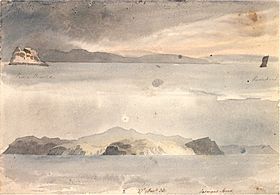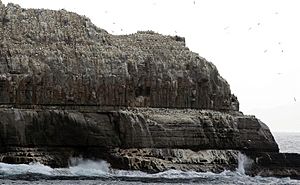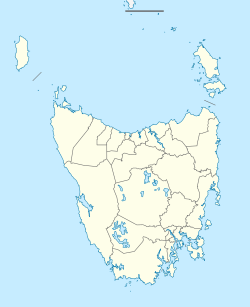Pedra Branca (Tasmania) facts for kids

An artist's impression of Pedra Branca and Eddystone, 1823.
|
|
| Etymology | Portuguese: "white rock" |
|---|---|
| Geography | |
| Location | Southern Ocean |
| Coordinates | 43°51′00″S 146°58′12″E / 43.85000°S 146.97000°E |
| Area | 2.5 ha (6.2 acres) |
| Length | 270 m (890 ft) |
| Width | 100 m (300 ft) |
| Highest elevation | 60 m (200 ft) |
| Administration | |
|
Australia
|
|
| State | Tasmania |
| Region | Southern |
| Demographics | |
| Population | 0 |
Pedra Branca is a small, rocky island in the Southern Ocean. It is located off the southern coast of Tasmania, Australia. This island is about 26 kilometers (16 miles) southeast of South East Cape. It is part of the Southwest National Park. This park is also a World Heritage Site. Pedra Branca is about 270 meters (886 feet) long and 100 meters (328 feet) wide. It rises 60 meters (197 feet) above the sea. Scientists believe it separated from Tasmania over 15,000 years ago.
Contents
Island Features and Location
Pedra Branca often has very wet and windy weather. Large waves frequently crash against its shores. The island is quite small, covering only 2.5 hectares (6.2 acres). Its size makes it an interesting example of a landform that is almost a rock, but also an island. The island's geology shows three cone-shaped formations. These are made of breccia, a type of rock, mixed with dolerite and sandstone.
Plants and Animals of Pedra Branca
The only plant species found on Pedra Branca is a succulent plant called Sarcocornia quinqueflora. This plant can store water in its leaves.
Many types of seabirds use the island for breeding. These include the fairy prion, Pacific gull, silver gull, and kelp gull. You can also find black-faced cormorants and Australasian gannets here. The shy albatross also breeds on Pedra Branca.
Australian fur seals often use the island as a place to rest. New Zealand fur seals visit occasionally too.
The Pedra Branca Skink
Pedra Branca is the only known home for a special type of lizard. This lizard is called the Pedra Branca skink, or Niveoscincus palfreymani. There are only about 400 of these lizards left. Because of their small numbers, this species is listed as vulnerable. This means it is at risk of becoming endangered.
Important Bird Area
Pedra Branca is part of an area known as an Important Bird Area (IBA). This IBA also includes nearby Eddystone and Sidmouth Rock. BirdLife International has identified this 2-hectare (5-acre) area as important. It is vital because it supports more than 1% of the world's population of shy albatrosses and Australasian gannets.
History of Pedra Branca
Abel Tasman was the first European explorer known to see Tasmania. In his journal entry from November 29, 1642, he wrote about seeing a rock. He said it looked like a rock named Pedra Branca off China. He was likely referring to the Pedra Branca in the South China Sea. His journal states that Pedra Branca was "about four [Dutch] miles" from the Tasmanian mainland. A Dutch mile from that time was about 5.8 kilometers (3.6 miles). So, four Dutch miles would be about 23 kilometers (14 miles). This distance is very close to the actual distance of Pedra Branca from South East Cape.
The name "Pedra Branca" means "white rock" in Portuguese.
Shipwreck Near Pedra Branca
On February 7, 1973, a Japanese fishing boat named Nisshin Maru No. 8 sank near Pedra Branca. The steel vessel, weighing 254 tons, was on its way to Hobart for repairs. It hit Pedra Branca and quickly sank. Out of 22 crew members, only one, engineer Yoshiichi Meguro, managed to climb onto the rocks and survive. Another fishing boat, the Walrus, rescued him.
This disaster led to important changes in how rescue operations were handled. Communications between different authorities improved. Direct links were created between Japanese fishing boats and Australian shore stations. Also, fishing vessels gained the ability to contact warships and military aircraft directly. Before this, they could not contact the Hobart emergency radio station at night.
Extreme Weather Conditions
The weather around Pedra Branca can be very harsh. The island is sometimes hit by extremely large, unexpected waves. On April 15, 2003, an ocean scientist named Hamish Saunders was swept off Pedra Branca and drowned. Witnesses said a huge wave hit the island. The spray from the wave went as high as 45 meters (148 feet) over the island. On that day, waves were measured up to 13.8 meters (45 feet) high. This measurement was taken by a special buoy about 100 kilometers (62 miles) away.
Surfing at Pedra Branca
Pedra Branca is famous among surfers for its huge waves. There is a "big wave" surf spot located on a reef about 40 kilometers (25 miles) offshore. Marti Paradisis was the first person to ever surf this challenging spot. Later, in 2008, famous surfers Ross Clarke-Jones and Tom Carroll joined Marti. They also surfed with local brothers James and Tyler Hollmer-Cross. Their adventure was even featured on the TV show 60 Minutes.
Images for kids





